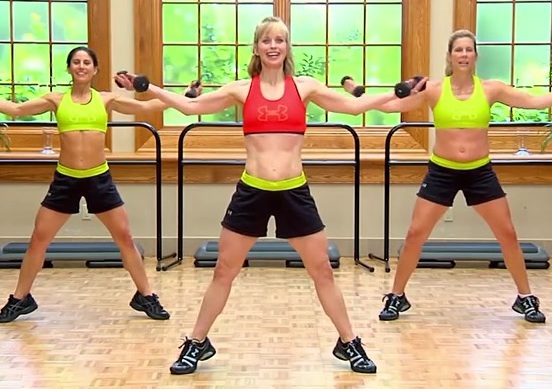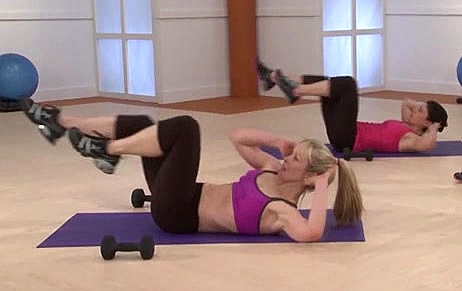In Part 1 of my 2-part interview with fitness video star & Gigabody featured instructor, Sharon Money Twombly, we discuss how Sharon’s work in physical therapy influences her fitness teaching, including how to fix 3 common mistakes that exercisers make which can lead to injury.
Part 2 of the interview focuses on Sharon’s personal fitness & diet regime. If you’re new to Sharon’s work, check out Sharon Money Twombly’s videos on Gigabody.
Part 1 – Fitness and Physical Therapy
Q: What came first, physical therapy or fitness? How did you end up getting into physical therapy?
I was very active when I was younger and danced for a long time. I was in ballet all the way up through high school and was in toe shoes. I really believe that having that strong base and strong core helped me with exercise. A lot of my fitness background comes from dance.
But for physical therapy, I was interested in that from the time I was in middle school. And later, through joining a gym, I met a couple of instructors and we did an aerobic competition and I started teaching. So I really brought both fields up side by side. I think they balance each other out really well.
I’m a better mom, a better therapist, a better a lot of things if I have my workout. It’s like the airlines – God forbid the plane’s going down and they drop the oxygen – take care of yourself first.
It’s great being a physical therapist and a fitness instructor because I feel like I have a better sense of body mechanics. I have a better sense of what is NOT so great for people, and have a better sense of how to break skills down. My specialty in physical therapy is pediatrics. I work with children birth to 21 with all kinds of diagnoses: autism, cerebral palsy, brain injury, chromosomal issues. I am constantly breaking skills down for them. If I’m going to be doing a complex move in one of my classes, I feel one of my skills is being able to break the move down so it makes sense for people.
I have a huge mix of people in my classes which I love. I live outside of Philadelphia, so I have students from Villanova who come and they’re 18-22 and they’re jumping to the ceiling. Then I have people who are a lot older. They all come and take class together. I tend to do a low impact version first and then go higher, they choose. I love having that mix because fitness has really got to last your whole life long.
Q: How do you incorporate Physical Therapy into your videos and into your classes?
There are a lot of back injuries where I work and there are a lot of people in my classes who will come in and say, “I’m going to take it easy today. I hurt my back.” So I do a lot of core for spinal stability.
In the morning, when you get up, I want your legs sore, I want your butt sore. I don’t want your back sore.
I had a knee injury one time and I had to do a lot of rehab for it. My rehab came right into my classes. We did a lot of work on the inside portion of your quadriceps muscle. It’s a really important one for women because it helps their kneecaps track a little bit straighter. We (women) all tend to track a bit off because our hips are wider. That still goes into my class.
And because lower back pain is an issue for a lot of people, I try to limit things like down to the floor, up from the floor-like burpees, even though they’re really big right now. If you’re younger, if you have pretty good core strength, they’re not a bad exercise. They’re very comprehensive. You’re going to hit every muscle group when you do them. At 21, you can do those. At my age I have to be careful. If I do floor to standing exercises one day, whatever workout I’m picking tomorrow is not going to have those exercises in there. I try to be really careful about what I ask my students to do, even if you’re 25, protecting your back is important.
If you’re doing some kind of a squat sequence or a jumping sequence where you touch the floor, most people bring their heads all the way down towards their feet. I’m constantly preaching, “Keep your head up. That bend should be in your legs. In the morning when you get up, I want your legs sore. I want your butt sore. I don’t want your back sore.” If your back is sore, you’re not going to come back.
Q: Are there things you see frequently where people do something wrong with their bodies that could hurt them? Where a simple fix could prevent an injury?
One of my big things — I say it when I teach and in my DVDs — is with abdominal crunches. So many people put their hands behind their heads. Even if they then get their shoulder blades off the floor, which some people do, it’s such a cranking force on your cervical spine. So I tell them, hands by your ears, hands by your cheeks. Your hands should not be behind your head. That’s one really, really big one.
With Abdominal Crunches… So many people put their hands behind their head…it’s such a cranking force on your cervical spine. I tell them, hands by your ears, hands by your cheeks.
Also, when you’re doing any kind of squats, any kind of single leg lunges, you’ve got to drop your weight back. You’re got to have that 90 degree angle in your ankle, in your knee, in your hip. Your front knee should be aligned over your front ankle. A lot of people do lunges with their knee going forward and it’s just so much compression- you need that 90 degree angle.
When you’re working out at home, it’s a little harder to monitor your mechanics if you’re trying to pick up the moves. At home I work out on carpet. It’s not my choice, it’s what I have. So when I do things- like my kickbox workout yesterday- I have to think about those leg pivots with all those punches. There’s a lot of friction on carpet and that weighted foot’s not going to spin. So I would caution home exercisers on carpet to watch your feet. If your foot’s not going to pivot then your knee’s going to take the rotation, and that may not be such a great thing.
Q: Is there anything that you recommend after a workout or between workouts to prevent injury?
I have one knee issue, bursitis. You have these little fluid-filled sacs in your joints called bursas, and mine, for whatever reason, in one of my knees, gets irritated easily. After most workouts, whether I come home from class or whether I finish in my living room, I ice with a bags of frozen peas that have probably been in my freezer for 2 or 3 years. I tell a lot of my members that ice is a really good thing. It’s not just for when the injury is acute and irritable. It’s actually a good maintenance tool to use.
Another thing I really believe in – and I have to tell you it’s like an annual new years’s resolution for me, I have to work so hard at it – I really believe you have to stretch. If you are doing kickboxing, all the bootcamps, all of the standing to ground work, activities like yoga are just crucial. I know that when I start to get those twinges, it’s time to hit a yoga workout. Ideally I would love to tell you I do it once a week, but it’s probably once every 3 weeks if I’m totally honest. But I need that.
(On yoga) When I work out, I love to pound the floor and be drenched in sweat because then all my stress is gone, but there truly is value to emptying your mind and taking in that 60 minutes of quiet.
There’s a place where I take class and when I go in the instructor always says,”Oh, the athlete’s here”. Because I’m easily the worst in the room and I’m so fine with being the worst in the room. You have to stretch those muscles out. You can’t work and work and not stretch. You can work really hard in yoga classes. I’m pretty muscular and I go in there and I am the weakest one. These people do the head balances and I just think, wow! It’s great to take a class where you are totally humbled. It’s crucial to go to those stretch classes, and that 2 or 3 minute stretch at the end of your workout, absolutely should be done. I think that helps prevent injury.
The other part of yoga that’s so important in our busy lives is that 60 minutes of quiet time. When I work out, I love to pound the floor and be drenched in sweat because then all my stress is gone, but there truly is value to emptying your mind and taking in that 60 minutes of quiet.
Exercise is so important for my well-being. I get up in the morning and one of my first thoughts is what I’m fitting in and when I’m fitting it in that day. I’m a better mom, I’m a better therapist, I’m a better a lot of things if I have my workout. It’s like the airlines- God forbid the plane’s going down and they drop the oxygen- take care of yourself first. If I get that workout in, I’m a happier, better person.
Q: Physical therapy is such a wonderful means of managing chronic problems, such as knee problems. Do you have patients that come in regularly, maybe just pay for themselves, not with insurance and not for an acute injury, just for maintenance, or to keep themselves in check managing chronic issues?
Yes, there are a lot of practices like that. There are many here on the east coast. You go through your rehab and then for a fee they let you continue to work out using their equipment. They might have 2 rows of equipment or treadmills. That way you’re back in your workout program and you can stay there as a gym client, but you’re still under their supervision. So when you get that twinge, you can get it checked out. It’s a great way to follow-up. We have that with kids too. I’ll discharge a child and the parents may call me later on to give the child a little tune-up.
Recap of Sharon’s Injury Prevention Tips:
- Abdominal Crunch: Proper form is hands by your ears or cheeks, not behind the head. Avoid pulling forward on the spine, and focus on lifting your shoulders off the floor instead.
- Squat or Jumping Sequence where you touch the floor: To protect your lower back, bend only in your legs to reach the floor, instead of bending your head down.
- Lunges & Squats: To protect your knees, keep a 90 degree angle in your ankle, your knee, and your hip. Don’t let your knee track forward over your foot.
- Icing after a workout is an excellent maintenance tool for keeping chronic joint issues in check.
- To prevent injury, stretch regularly, and always after a workout.
Continue to Part 2 of my interview with Sharon Money Twombly, where we discuss her personal fitness routine and thoughts on the obesity epidemic.

